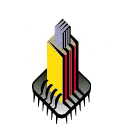|
|
Canku Ota |
|
|
(Many Paths) |
||
|
An Online Newsletter Celebrating Native America |
||
|
January 27, 2001 - Issue 28 |
||
|
|
||
|
School to Give Net Access to Tribes |
||
|
by Katie Burns staff writer for North Country Times |
||
 The University
of California at San Diego is providing high-speed wireless Internet access to three North County American Indian
reservations, and wants to expand the fledgling project to include other tribes. The University
of California at San Diego is providing high-speed wireless Internet access to three North County American Indian
reservations, and wants to expand the fledgling project to include other tribes.The university is using $2.3 million in funding from the National Science Foundation to create the prototype wireless network, known as the high-performance wireless research and Education Network. The network will connect reservations, ecological field stations, earthquake sensors and astronomical observatories to the Internet. These remote locations have limited or no access to cable, phone and power lines, all major ingredients of the Internet. "We wanted to implement something very affordable and efficient," said Hans-Werned Braun, the principal investigator for the project. So far, the UCSD team has hooked up the La Jolla and Pala Indian Reservations, and work is under way at the Rincon Indian Reservation. The reservations, all near Palomar Mountain, had dial-up connections previously. The UCSD team is enthusiastic about the success of its reservation connections and is searching for money to hook up more tribes. The group, which received its funding in August, already has built a backbone for the wireless network that spans several mountain tops and created a connection to Mount Laguna Observatory. The high-speed wireless network reaches the La Jolla Reservation via a solar-power relay installed by the team and the tribe. The network allows more than one computer to have fast access to the Internet while permitting tribal members to avoid the prohibitive cost of laying cable to an outlying location. "They're primarily interested in their tribe being brought up to speed with people who live in urban areas or in situations where they receive high-speed Internet connectivity," said Kim Bruch, a science writer for the San Diego Supercomputer Center at UCSD who is teaching Internet classes on the reservations. Bruch said the high-speed network will allow the tribe to download image-heavy Web sites. For example, she said, someone who can't visit the Smithsonian any time soon could wander the paths of its virtual museums. Members of the La Jolla tribe see many practical applications for the increased Internet availability. "We're going to be using the Internet to promote our businesses more," said Jack Musick, La Jolla tribal chairman. "The kids will be using it for homework and for all sorts of other things. You name it." Musick said children need to learn to use the Internet to prepare for future schooling, careers or the military. Children visit the education center as part of an after-school program. Adults also use the center's six computers. Musick thinks tribal committees on roads, water, finance and construction could use the Web for research. He envisions business classes and a Web site to advertise recreation on the reservation. "We have a small community and don't have the resources for computers, so any benefit and training will really assist our people," said Geneva Lofton Fitzsimmons, a member of the La Jolla tribe and UCSD's American Indian outreach coordinator. Fitzsimmons said the fast network connection will increase distance-learning possibilities using computers and cameras, such as tutoring from UCSD for children and college classes for adults. The Pala Learning Center's network connection has been very popular in the past few months. "With the wireless network, we have eight stations that are on," said Doretta Musick, director of the learning center and Jack Musick's sister. "They're filled up every day." She said children use the Internet after school to do homework and just to have fun. For adults, the center just began a second four-week Internet class. The class is the first time many adults have used a computer at all. "I took the little Internet class they offered," said Cathy Gonzales, a member of the Pala tribe who has a computer with dial-up access. "My husband and I took it. We're really like ding-dongs. The kids know everything. I didn't even know how to turn it on. "We feel better. We feel like doors have opened." Gonzales plans to use the Internet to find such information as how to keep the books and recipes for her catering business in her computer. |
|
UC San Diego Online News |
|
|
||
|
|
||
| Canku Ota is a free Newsletter celebrating Native America, its traditions and accomplishments . We do not provide subscriber or visitor names to anyone. Some articles presented in Canku Ota may contain copyright material. We have received appropriate permissions for republishing any articles. Material appearing here is distributed without profit or monetary gain to those who have expressed an interest. This is in accordance with Title 17 U.S.C. section 107. | ||
|
Canku Ota is a copyright © 2000, 2001 of Vicki Lockard and Paul Barry. |
||
|
|
The "Canku Ota - A Newsletter Celebrating Native America" web site and its design is the |
|
|
Copyright © 1999, 2000, 2001 of Paul C. Barry. |
||
|
All Rights Reserved. |
